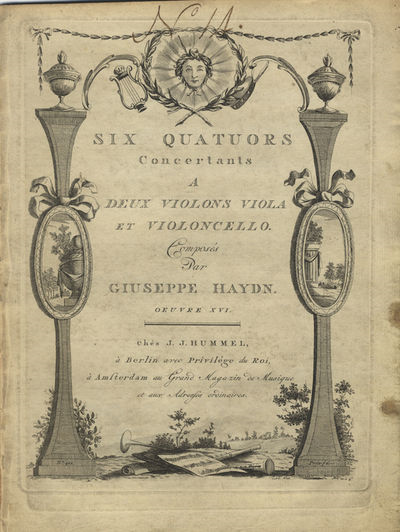
By Thijs Bonger
What does the sun have to do with Haydn’s string quartets? More than you might think. Because Haydn wrote so much music and it’s not so easy to remember all the opus numbers, all the nicknames are very handy. The six quartets opus 20 from 1772 were rapidly christened the ‘Sun Quartets’, because publisher Hummel from Amsterdam portrayed a rising sun on the title page. He probaly never realised how apposite the rising sun was, because it was just these quartets which started off a new age for this genre. We think of opus 20 as among his early works but he was already 40 and had already written about 50 symphonies. His development in the two genres didn’t run in parallel. In Haydn’s hands the string quartet comes to full maturity with opus 20. It now always has four movements and each instrument gets the same attention For centuries Haydon’ model has been an inspiration for later generations of composers.
Intelligent conversation
What did Haydn’t contemporaries think of these revolutionary quartets? Mixed views. The new equality between the four instruments led Goethe to call the string quartet ‘a stimulating conversation between four intelligent people’. But a letter from the same year in which Haydn wrote his “ Sun Quartets “ is less positive. The writer is critical of Haydn’s out-of-the-box thinking: ’ Listeners admired Haydn’s geniale ideas and his fantasy, but they found his combination of the comic and serious awful, especially because it was the comic which dominated. Why didn’t Haydon keep to the rules more often? Doesn’t he know them?’
Affetuoso
In the First movment of opus 20 nr. 1 we see how important the equality between the four instruments was for Haydn . Such as a cello solo which is written so high it’s notated in the violin key. Over the slow movment there’s a typical Sturm und Drang term: ‘Affetuoso’. Full of love. People who regard this as the summit of this quartet are in good company. In particular Haydon’s good friend Mozart, 24 years younger that him. We know that Haydn played quartets with him and this quarter most probably was in their repertoire. Mozart once wrote: ‘It was only from Haydn that I learned how to write string quartets’. There is a striking likeness between Haydn’s slow movement from opus 20 nr. 1 and Mozarts quartet in Es KV 428 11 years later. In Haydn’s slow movement we hear an apparently endless sttreaming melody for four voices, without an obvious melody and few dynamic contrasts . The continuous, almost invisible harmonic changes make this introverted section almost incomprehensible and mildly hypnotic. Minimal music ahead of its time. When you listen to this slow movement you can understand why the young Beethoven, a student of Haydn, in preparation for writing his own first string quartet, wrote out this quartet opus 20 nr. 1 note for note to go deeper into Haydn’s methods.
Not only Beethoven but also Mendelssohn was a huge admirer of Haydn’s string quartets opus 20. Brahms loved them too. He was a passionate collector of first editions and manuscripts. He was lucky enough to find the superbly written manuscript of these quartets. They were expensive!
In the next newsletter more about Haydn’s trendsetting quartets opus 20.
Listening
Looking for a fine recording? Lots of choices. The Doric String Quartet, the Chiaroscuro Quartet on historic instruments, the Hagen Quartett and, last but not least, our own Dudok Kwartet.








